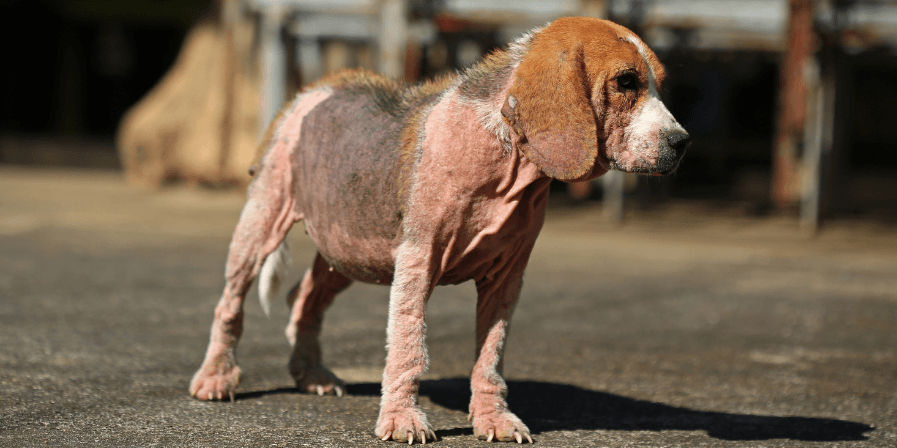Mange in Dogs: A Comprehensive Guide

Mange is a skin condition caused by microscopic mites that can lead to severe itching, hair loss, and skin infections in dogs. Understanding the types, symptoms, causes, and treatments of mange is crucial for dog owners to ensure their pets remain healthy and comfortable.
Mange is a skin condition caused by microscopic mites that can lead to severe itching, hair loss, and skin infections in dogs. Understanding the types, symptoms, causes, and treatments of mange is crucial for dog owners to ensure their pets remain healthy and comfortable.
Types of Mange in Dogs
1. Demodectic Mange (Demodicosis) • Caused by: Demodex canis mites, which are normally present in small numbers on all dogs but can cause issues when the immune system is compromised. • Symptoms: Hair loss, red and scaly skin, usually starting on the face, legs, or trunk. In severe cases, it can lead to bacterial infections and thickened skin. • Common in: Puppies and dogs with weakened immune systems.
2. Sarcoptic Mange (Scabies) • Caused by: Sarcoptes scabiei mites, which burrow into the skin causing intense itching. • Symptoms: Intense itching, red rash, hair loss, thick yellow crusts, and sores from scratching. Typically starts on the ears, elbows, and belly. • Highly Contagious: Can spread to other animals and humans.
3. Cheyletiellosis (Walking Dandruff) • Caused by: Cheyletiella mites, which are large enough to be seen with the naked eye. • Symptoms: Dandruff-like flakes, mild itching, and redness. The mites move under the scales, giving the appearance of moving dandruff. • Contagious: Can spread to other pets and humans.
Mange in Dogs Symptoms
1. Intense Itching and Scratching • Persistent scratching, biting, and licking of the skin.
2. Hair Loss • Patchy hair loss or thinning coat, particularly around the face, ears, legs, and trunk.
3. Red, Inflamed Skin • Redness, swelling, and inflammation of the affected areas.
4. Sores and Scabs • Open sores, scabs, and crusty patches due to excessive scratching and secondary infections.
5. Thickened Skin • In chronic cases, the skin may become thickened and leathery.
6. Dandruff • Flaky skin that resembles dandruff, often more noticeable in Cheyletiellosis.
Mange Causes in Dogs
1. Weakened Immune System • Dogs with weakened immune systems are more susceptible to demodectic mange.
2. Close Contact with Infected Animals • Sarcoptic mange and Cheyletiellosis are highly contagious and can be spread through direct contact with infected animals.
3. Poor Living Conditions • Unsanitary living conditions and overcrowded environments can increase the risk of mite infestations.
4. Genetics • Some breeds are more predisposed to developing mange due to genetic factors affecting their immune response.
Treatment and Prevention
1. Veterinary Diagnosis and Treatment • Diagnosis: Skin scrapings and microscopic examination to identify the type of mites. • Medications: Prescription medications such as ivermectin, milbemycin, selamectin, or moxidectin. Topical treatments and shampoos may also be recommended. • Antibiotics: For secondary bacterial infections.
2. Environmental Cleaning • Regular cleaning of bedding, toys, and living areas to eliminate mites and prevent re-infestation.
3. Boosting Immune Health • Providing a balanced diet, regular exercise, and minimizing stress to strengthen the dog’s immune system.
4. Isolation • Keeping infected dogs isolated from other pets to prevent the spread of contagious mange types.
5. Regular Check-ups • Routine veterinary check-ups to monitor the dog’s health and catch any signs of mange early.
By recognizing the symptoms and understanding the causes of mange, dog owners can take appropriate steps to treat and prevent this uncomfortable condition. Always consult a veterinarian for an accurate diagnosis and effective treatment plan tailored to your dog’s specific needs.
FAQ’s:
1. How long does it take for a dog to recover from mange? • Recovery time varies depending on the severity and type of mange, as well as the effectiveness of the treatment. It can take several weeks to months for complete recovery.
2. Are certain dog breeds more prone to mange? • Some breeds may be more predisposed to developing mange due to genetic factors that affect their immune response. Consult your vet if you have concerns about your dog’s breed and susceptibility.
For best veterinary hospital in Delhi, Gurgaon and Noida, please give us a call on 9311560101 or log on to dccpets.in.


 How can we help?
How can we help?